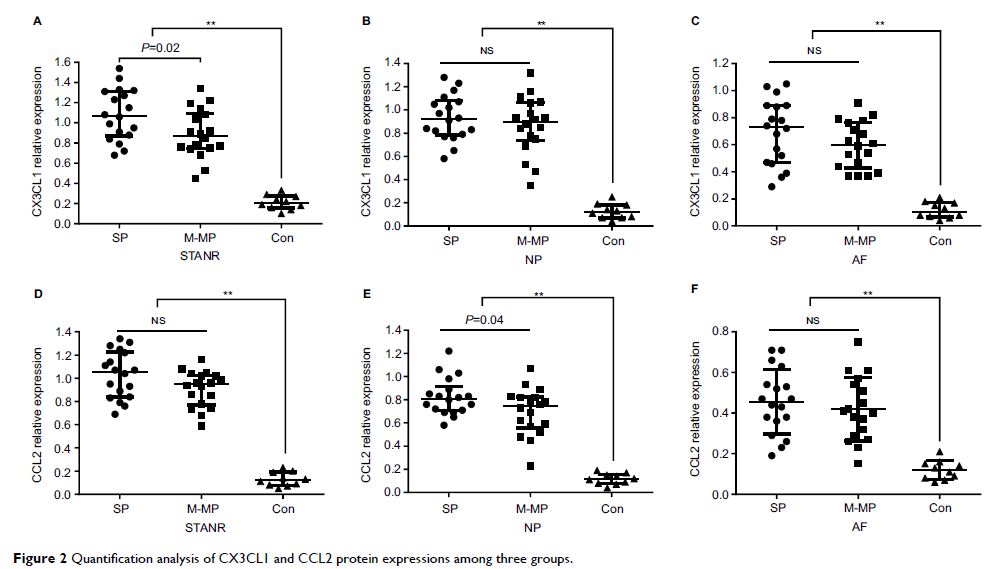9 9 6 5 3
论文已发表
注册即可获取德孚的最新动态
IF 收录期刊
- 3.3 Breast Cancer (Dove Med Press)
- 3.4 Clin Epidemiol
- 2.5 Cancer Manag Res
- 2.9 Infect Drug Resist
- 3.5 Clin Interv Aging
- 4.7 Drug Des Dev Ther
- 2.7 Int J Chronic Obstr
- 6.6 Int J Nanomed
- 2.5 Int J Women's Health
- 2.5 Neuropsych Dis Treat
- 2.7 OncoTargets Ther
- 2.0 Patient Prefer Adher
- 2.3 Ther Clin Risk Manag
- 2.5 J Pain Res
- 2.8 Diabet Metab Synd Ob
- 2.8 Psychol Res Behav Ma
- 3.0 Nat Sci Sleep
- 1.8 Pharmgenomics Pers Med
- 2.7 Risk Manag Healthc Policy
- 4.2 J Inflamm Res
- 2.1 Int J Gen Med
- 4.2 J Hepatocell Carcinoma
- 3.7 J Asthma Allergy
- 1.9 Clin Cosmet Investig Dermatol
- 2.7 J Multidiscip Healthc

CX3CL1 和 CCL2 的局部表达增加与有坐骨神经痛的腰椎间盘突出症患者的临床症状严重程度有关
Authors Peng ZY, Chen R, Fang ZZ, Chen B, Wang ZH, Wang XY
Received 27 October 2016
Accepted for publication 14 December 2016
Published 17 January 2017 Volume 2017:10 Pages 157—165
DOI https://doi.org/10.2147/JPR.S125914
Checked for plagiarism Yes
Review by Single-blind
Peer reviewers approved by Dr Colin Mak
Peer reviewer comments 2
Editor who approved publication: Dr Michael Schatman
Background: Chemokines have been identified to be involved in the modulation of pain
through both peripheral and central mechanisms. However, the role of chemokines
in lumbar disk herniation (LDH) with sciatic pain remains unknown.
Objective: The current study was performed to explore the
expression of two most commonly studied chemokines CX3CL1 and CCL2 and assess
their associations with clinical severity in LDH patients with sciatic pain.
Methods: The soft tissues around nerve root (STANR), annulus
fibrosus (AF), and nucleus pulposus (NP) biopsies were obtained from 36 LDH
patients with chronic sciatic pain and 10 scoliosis patients (painless
controls). The serum and local expressions of CX3CL1 and CCL2 were determined
using enzyme-linked immunosorbent assay and Western blot analysis,
respectively. The visual analog scale (VAS) scores for low back pain and lower
extremity pain and Japanese Orthopaedic Association (JOA) scores were recorded
on the day of hospital admission to evaluate the clinical severity. LDH
patients with sciatic pain were divided into severe pain (SP) group (VAS ≥7;
n=18) and mild-to-moderate pain (M-MP) group (VAS <7; n=18) for lower
extremity pain.
Results: Local expressions instead of CX3CL1 and CCL2 in STANR,
AF, and NP were significantly higher in the SP group than in M-MP compared with
scoliosis painless group. Expressions of both CX3CL1 and CCL2 in STANR and AF
were positively correlated with VAS scores for lower extremity and for low back
pain, respectively. In addition, CX3CL1 and CCL2 expressions in STANR were
negatively associated with JOA scores. There were no significant differences of
serum CX3CL1 and CCL2 levels among SP group, M-MP group, and scoliosis painless
group.
Conclusion: Both CX3CL1 and CCL2 may play important roles in
maintaining pain in LDH patients. Local blockade of CX3CL1 and CCL2 in LDH
patients with persistent pain deserves further intensive study.
Keywords: lumbar disk herniation, sciatic pain,
CX3CL1, CCL2
